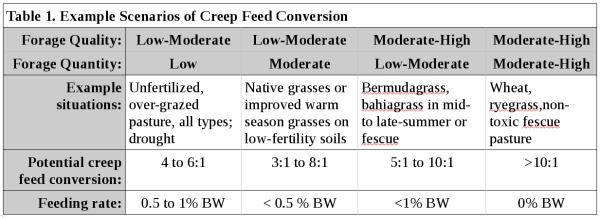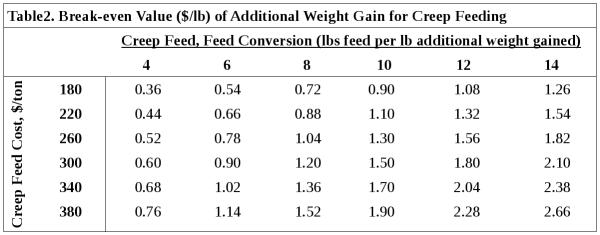Should I Creep Feed?

This time of year, cattle producers begin to ask ‘Should I creep feed my calves?’. The answer isn’t as simple as yes or no. There must be a definitive purpose for creep feeding and purposes may include:
- Increase weaning weight of purebred bulls and heifers
- Increase growth and maturity in replacement females
- Increase weaning weight of commercial market calves (steers and heifers)
- Take nursing pressure off the cow
- My neighbor creep feeds
While some of these bullets are justifiable, others are erroneous and some have the potential to be detrimental to both production and the pocketbook. For instance, heifers that become fleshy early in life due to creep feeding may have reduced milk production as a first-calf heifer and market data shows fleshy to fat cattle are discounted $5 to $18/cwt. Arkansas markets during the week of May 29, 2014 reported fleshy heifers, although few in number, discounted $17/cwt.
A common myth is creep feeding calves provides relief to the cow. Calves that are creep fed will continue to nurse their dams; therefore, creep feeding won’t be a direct benefit to the cow. If creep feeding benefits the cow, it will most likely be an indirect response to having slightly more available forage if calves are being creep fed at a high enough rate to substitute creep feed in place of pasture.
Forage quality and quantity should be the initial determinant of the creep feeding decision. Creep feed is essentially a supplement to or substitute for pasture forages during the 60 to 90 days prior to weaning when a substantial part of the calf’s diet is no longer milk, but pasture. By this point in a calf’s life, milk has become more of a supplemental food source.
The economic return to creep feeding is influenced by creep feed, feed conversion and feed cost. Creep feed, feed conversion is the amount of additional weight gain associated with creep feeding. For instance, if calves gain, on average, 2.25 lb per day without creep feed but gain 2.5 lb per day when fed 1 lb of creep feed per calf, daily, the creep feed conversion is 1 / (2.5-2.25) = 4 lb feed per lb additional weight gained.
Table 1 below provides a guideline for possible creep feed conversion ratios given various categories of forage quality and quantity.
To help determine the break-even point between creep feed, feed conversion and feed cost, table 2 provides the break-even value of the additional weight gained.
While forage quality and quantity will ultimately determine calf response to creep feeding, feed price and calf value will ultimately determine return on investment for calves that will be marketed after weaning.
A common mistake when evaluating the value of gain is to apply current market price as the value of gain. In Arkansas, 550 lb steer calves were averaging $208/cwt the week ending May 29, 2014. Although these calves are selling for $2.08 per pound, this is not their value of gain.
To examine the value of additional weight gain based on current market prices, calculate the difference in total gross income for two different weights and divide that value by the difference in weight to estimate value of gain. For example, 475 lb number 1 steers were selling for $2.23/lb and 525 lb number 1 steers were selling for $2.13/lb. The value of gain from 475 to 525 lbs is (1118.25 – 1059.25) / 50 = $1.18/lb.
Based on the value of gain and using table 2 above, if creep feed costs $260/ton delivered, steers would need to convert creep feed to weight gain at a rate less than 9 lbs feed per lb of additional weight gain. This rate of creep feed conversion or better could be expected when forage quality or quantity is moderate to low. If creep feed were to cost $320/ton, it is very unlikely feed conversion will be good enough to be profitable.
As a general rule, lower supplementation rates have better feed conversions. If forages are low in protein but not limited in the total amount available for grazing, place more emphasis on supplementing with just 1 to 2 pounds of a high protein supplement. If forages are moderate in protein content or forage quantity is limiting, consider a moderate protein supplement, and if necessary, feed at higher rates (1% body weight) when forage substitution is needed.
Source: University of Arkansas







